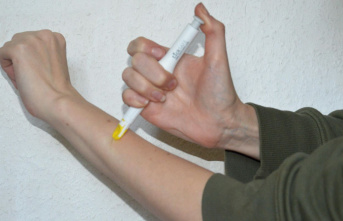Eating, drinking, talking, smiling, kissing… “The mouth is so invested in the sensory, physical and psychological level, that it should not be neglected”, underlines Dr. Alain Amzalag dental surgeon in Paris. Despite the prevention messages, the French remain poor students in terms of oral hygiene. In 2019, one in four admitted brushing their teeth less than twice a day. The toothbrush is more often changed every 8 months than every 3 months. One in three French people has not been to the dentist for over a year. And that doesn't get better with age.
According to a survey conducted in 2019 by the Pays de la Loire Regional Health Observatory (ORS), while 43% of 55-year-olds saw a dentist in 2017, this rate decreases continuously from the age of 65, to reach 25% at age 90. Among the causes put forward: fear of pain. “It is not the care that hurts, but the oral pathologies”, recalls the French Union for Oral Health (UFSBD). Another argument put forward: insurmountable costs... "Yet we are lucky to live in a country that takes charge of preventive care, it would be enough to respect them in order not to develop pathologies leading to more expensive care", insists Dr Amzalag.
Having bleeding gums, as is the case for one in two French people, means risking chronic gingivitis. Untreated, it leads straight to periodontitis, with serious consequences for the whole body. "You can't be healthy if your mouth isn't," summarizes Dr Christophe Lequart, dental surgeon in Touraine and spokesperson for the UFSBD.
Dentists hammer it: the oral cavity is not a world apart. The vigor and balance of the teeth, tissues and bones that support them, of the flora that cohabit there, condition all of our health.
Food
To have teeth so damaged that you end up losing them means forgetting your smile, possibly having difficulty speaking, but above all eating a balanced diet, as the recommendations of the national health nutrition program (PNNS) suggest. . "Even if it's not visible, a missing molar affects the way you chew. The remaining teeth then start to move and in some cases, there may be bone loss all around the area where a tooth is missing, ”underlines the French Union for Oral Health (UFSBD) for which there is there is no fatality to losing natural teeth as you age. "Even if there is physiological loosening with age, it is not enough to cause tooth loss, mainly due to bacterial infections", insists Dr. Christophe Lequart, dental surgeon in Indre-et-Loire. and UFSBD spokesperson.
Chewing less well, and therefore eating, is all the more problematic as we get older, exposing ourselves to undernutrition and its consequences: muscle wasting, risk of falls and dependence. The health of the mouth remains however the great forgotten in the prevention of undernutrition, from which 2 million people suffer, whereas it is one of the main causes, deplores the UFSBD.
The alignment of the skeleton
Joint or muscle pain related to oral health? This is not a view of the mind. "High-level athletes know this and pay great attention to it," says Dr. Lequart, who follows the dental health of volleyball players in Tours. “During the Mercato, the transfer at a golden price of important football players is only carried out subject to a perfectly healthy oral state”, adds Dr Alain Amzalag, dental surgeon in Paris. The link, he explains, is logical: “The jaw is the first movable joint of the body and the harmonious interlocking of the teeth, which we call dental occlusion, conditions the balance of the skeleton.” Missing or badly positioned teeth, an imperfectly adapted crown or prosthesis: a shift of a tenth of a millimeter can be enough to cause a deviation of the jaw. “As soon as the body, which normally functions in two perfectly symmetrical halves, sees its center of gravity deflected, continues Dr. Lequart, there can be repercussions.” Upward, poor bite can induce chronic headaches and dizziness, or promote teeth grinding (bruxism), which disrupts sleep. Downward, this affects the alignment of the spine, from the cervical to the lumbar, “with, sometimes, a slight shift in the hip”, assures Dr. Lequart. Asymmetrical painful muscular tensions can then appear: contractures or even tears, tendonitis in the lower limbs, or repeated pubalgia.
The balance of the oral flora
At 36°C, always humid, the mouth is an ideal oven: more than 700 bacterial species have been listed there. Some have a protective role; others, such as Streptococcus mutans and Porphyromonas gingivalis can be harmful if profiled too much. “The healthier your mouth, the less aggressive bacteria you have,” explains Dr. Lequart. And the secret of a healthy mouth is the harmony (eubiosis) of all this little world. “But the oral flora is fragile and at the mercy of an imbalance. This dysbiosis is linked to a combination of factors: individual, family susceptibility, probably a multi-genetic factor, and environmental, ”lists Professor Marjolaine Gosset, researcher at the Faculty of Dental Surgery in Paris.
By environment, we mean habits: "Failing dental hygiene, diet hyperrich in carbohydrates and lipids but depleted in micronutrients, smoking," explains the periodontologist. Certain drugs can also weaken the balance, when they are bactericidal (antibiotics) or when they reduce the production of saliva, which helps neutralize acids after certain food intakes (hypertensives, antihistamines, antidepressants).
The sleep
Painful jaw, headaches, more sensitive teeth are signs that may indicate that you suffer from bruxism. “The origin of this involuntary, and most often nocturnal, teeth grinding is linked to excess stress, which crystallizes on the temporomandibular joint,” explains Dr. Amzalag. In addition to influencing the quality of sleep, it is not without impact on the oral sphere since it causes increased wear of the teeth and a risk of significant joint disorders in the jaw around 40-50 years. . Among the countless effects of the Covid pandemic, dentists have observed a growth in cases of bruxism. A survey conducted by Israeli researchers highlighted the increase in the proportion of teeth grinders, from 10 to 36% during the first confinement. In March 2021, the American Dental Association noted a 71% increase in pathologies linked to clenching of teeth. To avoid their damage, the dentist can prescribe a gutter, to be worn at night. Made to measure, similar to sports mouthguards, it reduces muscle pressure and the wear imposed on the teeth.
Deleterious for the lungs, the throat, the heart… The effects of tobacco are just as disastrous for the oral sphere. It causes bad breath and stains on the teeth. And like alcohol, it also increases the risk of oral cancer. From 45-50 years old, they can affect any area (lips, gum tissue, tongue, palate). They manifest as a sore that bleeds and does not heal, a small thickened, rough or crusty area. Suspicious lesions that the dentist also tracks down when he inspects your mouth.
Smoking is also a major risk factor for periodontal disease when you have diabetes, especially if it is poorly balanced. But that's not all. “With each puff of a cigarette, the temperature can rise up to 70°C in the mouth, explains Dr Alain Amzalag. You don't feel it, because the saliva acts as a buffer, but the effects are there.” Vasoconstrictors first: the vascularization of the gums is reduced, which slows down healing in the event of surgery, but also makes them more vulnerable to attacks by dental plaque. However, this is also favored by tobacco, which increases acidity and dryness in the mouth, by modifying the antibacterial properties of saliva. Result: a weakened periodontium and increased dental loosening.
If dentists insist on brushing your teeth twice a day, it is because “the microbiota is deposited everywhere, explains periodontologist Marjolaine Gosset. On the mucous membranes and soft tissues, it is permanently eliminated by desquamation. On the teeth, on the other hand, it forms a biofilm”. More commonly known as dental plaque, this biofilm is our worst enemy. If this mixture of saliva, food debris and bacteria is not regularly eliminated, it accumulates on and between the teeth, and calcifies at the junction between teeth and gums. A scale that promotes the proliferation of the most harmful bacteria.
When the biofilm contains too many Streptococcus, which produce acids attacking tooth enamel, it leads to decay. When Porphyromonas proliferates, there is a risk of developing periodontal disease, which attacks all the supporting tissue of the teeth (the periodontium).
At the first stage, this pathology is limited to the gums. When it is swollen, sensitive and bleeds when brushing: it is gingivitis. It can turn into periodontitis, the consequences of which can be severe, in the absence of treatment. In the mouth, it leads to the gradual receding of the gums, then to the loosening of the teeth.
Extra-oral consequences
Without care, bacterial proliferation gains, in fact, the deeper layers. The alveolar bone resorbs. The teeth, which are no longer maintained at all, move and eventually fall out. For 20 years, studies have shown that the proliferation of these bad bacteria can seriously threaten the body, well beyond the mouth.
“Your scalp would start bleeding, you would immediately go to see a doctor. For the gums, it's the same: we must not let them bleed”, insists the dental surgeon Christophe Lequart. As we know, a cavity, which first manifests itself by hypersensitivity to hot or cold before evolving into frank pain, rushes us to the dentist. On the other hand, gingival bleeding is too rarely considered as a reason for consultation. However, neglecting gingivitis, when this inflammation is reversible if it is treated, not only runs the risk of it becoming chronic, but also that it turns into periodontal disease. The melting of the tissues and bone that support the teeth can be stabilized by regular deep scaling (curettage or surfacing), antibiotic treatment sometimes, and tenfold dental hygiene, but it cannot be recovered.
Without intervention, the focus that grows deeper and deeper below the gumline, in so-called periodontal pockets, is just waiting to thrive and spread. “When periodontitis is severe, if you add up all the small wounds that make up the periodontal pockets, this is equivalent to the surface of the palm of a hand,” explains periodontologist Marjolaine Gosset. That is a gateway of almost 200 cm2, for inflammatory molecules and bacteria. “As the periodontium is richly vascularized, its damage can thus trigger chronic inflammation throughout the body that cannot be detected by a blood test, but is likely to promote the development of other pathologies,” she explains. "As for bacteria, they can not only be swallowed, breathed in - at the risk of causing pneumonia, especially in the elderly - but also migrate into the general circulation and induce or promote serious illnesses, away from the mouth", highlights guard Dr. Lequart. This link between oral and extra-oral diseases has been the subject of a growing number of scientific studies over the past twenty years.
Endocarditis
“In a healthy subject, oral bacteria can cross the body without any problem, underlines Dr. Alain Amzalag. But if the patient already has a fragility of the heart tissue, the valves or if he has a valve prosthesis, they can induce endocarditis. This bacterial infection of the lining of the heart or the valves can lead to fatal complications (insufficiency or embolism), if it is not treated quickly. As a preventive measure, cardiologists recommend to these patients at risk a six-monthly visit to the dentist to control and avoid any infectious focus in the mouth. “Also as a precaution, the scientific consensus recommends premedication before any bloody dental procedure such as an extraction, and even a scaling”, explains Dr. Christophe Lequart, who prescribes a single dose of 2 grams of penicillin, one hour before the intervention.
Cardiovascular illnesses
Bad bacteria in the mouth also threaten the health of the arteries. "In 1993, a study conducted in Finland on subjects followed since the age of 10 showed that those who had had incomplete dental care developed more cardiovascular disease at age 40," says Dr Amzallag. Since then, work has multiplied, now firmly proving the link between periodontal disease, systemic inflammation and pathologies or cardiovascular accidents (1).
It multiplies the risk by 1.3. In 2017, a review of studies (meta-analysis) pointed to a significant association between periodontitis and myocardial infarction (2). Periodontitis is strongly suspected of accelerating the deposition of cholesterol in the arteries, promoting the formation of atherosclerotic plaques (atherosclerosis), which reduce the elasticity and diameter of the arteries, thus increasing the risk of stroke. The analysis of samples of diseased arteries in victims of coronary accidents has made it possible to identify around twenty bacteria involved in periodontitis, including Porphyromonas gingivalis. “Recent work carried out on victims of hemorrhagic strokes has also identified the presence of oral bacteria at the site of the accident, including the famous Streptococcus mutans, involved in caries,” says Dr. Lequart. In 2016, an American-Japanese team published its results in the journal Nature, after monitoring 100 patients admitted urgently for hemorrhagic stroke. 26% of them were found to be contaminated by this oral bacterium, compared to only 6% among victims of ischemic stroke(3). "This statistical link does not allow us to conclude that a poorly treated cavity is the cause of the stroke, but it is undoubtedly a contributing factor", specifies Dr. Lequart.
Diabetes
In people with diabetes, periodontal disease is a risk to be taken very seriously. The link between the two pathologies is the most documented in the scientific literature. “It is now established that periodontitis is the 6th complication of diabetes,” warns Dr. Lequart. Hence the recommendation of at least 2 visits per year to the dentist. The interaction is two-way. Diabetes, which induces poorer vascularization of the extremities, poorer healing and less inflammatory response, facilitates the development of periodontitis. However, periodontal disease, through the inflammation mediators it secretes, promotes insulin resistance (4) and blood sugar imbalance. A study published in The Lancet in 2018 confirms this, showing that treating periodontitis in a patient with type 2 diabetes helps regulate blood sugar (5). The glycated hemoglobin level, which measures the glycemic balance over time, is improved by 0.15%. "This is more than the 0.10% improvement provided by the 150 minutes of weekly physical activity recommended for people with diabetes", insists the dental surgeon.
The pregnancy
Periodontal infections would increase the risk of premature delivery. The Epipap study (6), conducted by the National Institute for Health and Medical Research (Inserm), evaluated it in six French maternity wards, on 1108 women who had just given birth to a premature child (before 37 weeks of amenorrhea) and 1094 women (control cases) who gave birth at term. Results: the estimated frequency of periodontitis in young mothers is estimated at 24%, and this periodontal disease is associated with an increased risk of premature delivery, due to pre-eclampsia, a complication of pregnancy combined with hypertension. blood pressure and the appearance of protein in the urine. A previous study of 200 young mothers estimated that women suffering from periodontitis are 3.2 times more likely to give birth to a low-weight baby, and 3.4 times more likely to give birth before term (7).
Since 2018, several studies have revealed an astonishing link between the dreaded bacterium Porphyromonas gingivalis and Alzheimer's disease. The first, published in the journal Plos One, reported typical signs of neurodegenerative disease (neurodegeneration, production of amyloid peptide, which, when aggregated, form the characteristic Alzheimer's amyloid plaques) in mice, which had been triggered chronic periodontitis, by subjecting them regularly to this bacterium. By analyzing the brain of sick subjects, and particularly the hippocampus, a key structure for memorization affected in Alzheimer's disease, we also found the famous bacteria there.
In January 2019, the publication of an international study, this time conducted on post-mortem analysis of human brain tissue, confirmed that the brain is not impervious to oral dysbiosis (8). Researchers have revealed the presence of gingipains in the neurons of people with Alzheimer's disease: these proteins are secreted by Pophyromonas. While these findings do not establish a direct causal link, they do suggest that untreated periodontal pathology may contribute to the development of neurodegenerative disease.
Several studies have observed an epidemiological link between periodontal disease and inflammatory bowel disease (IBD). They appear more frequent in people suffering from Crohn's disease or ulcerative colitis. “However, these studies are not numerous enough or solid enough to deduce a causal link,” emphasizes Professor Marjolaine Gosset. However, they reveal an association, which could be explained by a modification of the oral microbiota in these patients and a high release of pro-inflammatory cytokines. The same mechanism could explain the higher prevalence of periodontal disease in people with polyarthritis. The Porphyromonas bacterium would play a role, if not to trigger polyarthritis at least to promote it. In fact, joint inflammation and deformity of the hands make effective tooth brushing more complicated.
As dental surgeon Alain Amzalag reminds us, “the best dentist is you!”. Committing to regular oral hygiene is, in fact, the first and best way to maintain a healthy mouth throughout your life.
Brush teeth and gums
Manual or electric brushing, with a soft-bristled brush and fluoridated toothpaste, is the cornerstone of oral hygiene. Two minutes, the time of a song, twice a day: this is the minimum duration. “This is enough, as a general rule, because the dental plaque takes about twelve hours to reconstitute itself,” explains Dr. Christophe Lequart, dental surgeon and spokesperson for the UFSBD.
“Brushing your teeth well is a real job,” warns Dr. Alain Amzalag. "And can be learned," adds Professor Marjolaine Gosset. Instead of working hard along the gum line, on the contrary rub gently: one tooth after another, always from the gums towards the tooth, on the external then internal face; then laterally on the edge of the molars and teeth.
Floss the dental floss
“There are spaces between the teeth that no brush, no matter how good, can reach,” says Dr. Amzalag. To prevent dental plaque from becoming encrusted, with bacterial proliferation threatening the periodontium, it is necessary to access them to clean them in addition to brushing, at least once a day (at each brushing in the event of gum disease), with dental floss or interdental brushes.
Make mouthwashes
There is nothing to prevent you from finishing brushing with a mouthwash, provided you are not mistaken. Antiseptic baths, based on chlorhexidine, sold in pharmacies, should be reserved for temporary use, when the dentist prescribes them to disinfect a wound or after surgery. Prolonged use would destabilize the oral flora. Among the plethora of daily mouthwashes, you have the choice between those enriched with fluoride or arginine, which reinforce the effect of toothpaste, or those which neutralize bad breath. “It is better to opt for a mouthwash with 0% alcohol, without the risk of drying out the oral cavity,” recommends Dr. Amzalag. In any case, “mouthwash does not replace brushing!” insists Dr. Lequart.
Watch your diet
The mouth is the gateway to food, which influences all of our health, including that of the teeth and gums. "There is a concordance between the recommendations of the national health nutrition program and the balanced diet recommended according to studies for good periodontal health", underlines Professor Marjolaine Gosset.
Nothing beats a balanced diet, rich in fruits, vegetables and starchy foods (complex carbohydrates), moderate in meats, eggs and fish and low in simple sugars which hide not only in sodas, but also in “junk food”. The risk of ready to eat at any time, warns the UFSBD, is also snacking throughout the day, which is just as harmful to oral health.
Visit the dentist regularly
Make an appointment with the dentist at least once a year, even if you don't have any chronic conditions, if your teeth look healthy and aren't painful. Especially after the age of 60, warns the UFSBD, the nerves inside the teeth become smaller and less sensitive: by the time you feel pain, the damage could be deeper, putting you at risk of losing a tooth. This control visit makes it possible to detect carious and especially periodontal infections, by evaluating the loosening of the teeth, which can be prevented by scaling.
“The proverb “One child, one tooth” is a received idea”, protests Dr Christophe Lequart. There is no reason, a priori, to lose a tooth when you are pregnant. "The first few months, there may be pregnancy gingivitis related to hormonal changes, which causes swelling of the gums, but it disappears after pregnancy," he explains.
It is more than ever necessary to brush your teeth regularly and properly. Since the increase in progesterone and estradiol promote inflammation and reduce immune defenses, the composition of saliva is modified. It then becomes more acidic and can promote the development of cavities, especially when you tend to snack. It is therefore essential to maintain good oral hygiene.
(1) Heart lung circ. 2018 Nov; 27(11): 1327-1334. (2) European Journal of Epidemiology Jan 2017 32 (1): 43-53. (3) Sci Rep 6, 20074 (2016). (4) Gut. 2017 May;66 (5): 872-885. (5) Lancet Diabetes Endocrinol. 2018 Dec ; 6 (12):954-965. (6) Actual. Odonto-Stomatol. 2014 ; 267: 20-26. (7) J Clin Periodontol. 2010 Jan ; 37 (1): 37-45. (8) Sci Adv. 2019 Jan 23 ; 5 (1): eaau3333












